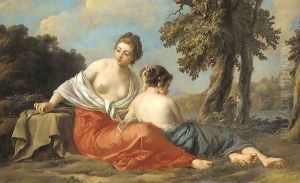Jean Baptiste Pierre Paintings
Jean-Baptiste Marie Pierre was a French Rococo painter, draughtsman, and administrator. Born on March 6, 1713, in Paris, France, Pierre was an influential artist in his time, though his renown has been somewhat overshadowed by contemporaries like François Boucher and Jean-Honoré Fragonard. He began his artistic education under Charles-Joseph Natoire, a prominent French painter of the time. Pierre then furthered his studies at the French Academy in Rome, which was a crucial stepping-stone for many artists of the period.
Pierre became known for his history paintings, a genre considered the most prestigious at the time. He was adept at handling various subjects, including classical antiquity, religious themes, and occasionally contemporary events. His style was characterized by its clarity, controlled brushwork, and classical approach, which contrasted with the more free and sensuous style of his Rococo counterparts. Pierre's work was well-received, and he garnered numerous commissions for religious institutions, as well as for the French court.
Throughout his career, Pierre was deeply involved with the Académie Royale de Peinture et de Sculpture. In 1752, he was appointed as a professor there and eventually rose to the position of Director of the French Academy in Rome in 1754. This role was of significant importance as it allowed him to influence the development of French art and to mentor the next generation of artists. His tenure in Rome lasted until 1775, after which he returned to Paris.
Upon his return to France, Jean-Baptiste Marie Pierre continued to be an active member of the art community. In 1770, he was appointed as the Premier Peintre du Roi, or the First Painter to the King, by Louis XV, succeeding François Boucher. This was one of the highest honors for an artist in France, affirming Pierre's status and contributions to French art. He held this prestigious position until his death in 1789.
Jean-Baptiste Marie Pierre's legacy includes his impact on the French art scene of the 18th century, particularly through his administrative roles and his promotion of neoclassicism. His works can be found in various museums and collections around the world, showcasing the transition from the Rococo to the Neoclassical style that defined the era's aesthetic evolution.
